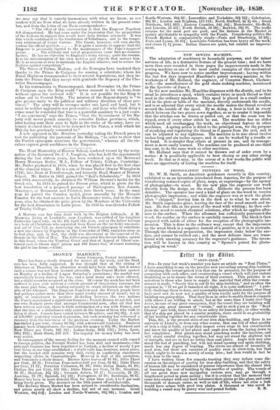EHOTOGRAPIIIC PRINTIDTG ON WOOD.
Mr. W. M. Smith, an American gentleman recently in this country, exhibited to us an invention introduced from America, for the purpose of transferring reduced copies of plans, maps, or engravings—by the agency of photography—to wood. By the new plan the engraver can work directly from the design on the wood. Hitherto the process has been defective. The operator has used a kind of glaze on the wood to receive photographic impression ; and while the engraver was at work the glaze often "chipped," leaving him in the dark as to what he was about. Mr. Smith supersedes glaze, leaving the face of the wood smooth and in- tact. He first fills in the pores of the wood with whiting; he then sub- jects the wood to certain chemical solutions, after which he applies albu- men to the surface. When the albumen has sufficiently penetrated the wood, the residue on the surface is carefully removed. The block is then prepared with iodide of silver for the reception of the photographic im- pression. This is done in the ordinal', way, except that the impression on the wood block is a negative instead of a positive, as it is in portraits. Through the chemical preparation, the impression sinks below the sur- face and cannot be rubbed out ; and the most delicate lines are trans- ferred with unerring accuracy for the engraver's guidance. The inven- tion will be known in this country as "Spence's patent for photo- graphing on wood."


























 Previous page
Previous page